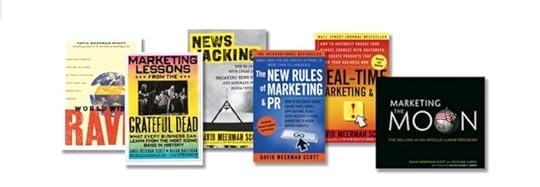David Meerman Scott's Blog, page 65
May 20, 2014
Not so new: Apps and infographics from 45 years ago
 When discussing the world of web content and social media, many people like to say how everything is new and different and untested: Smartphone apps! Infographics! Content marketing!
When discussing the world of web content and social media, many people like to say how everything is new and different and untested: Smartphone apps! Infographics! Content marketing!
Instead of getting all hot and bothered about the newness of this stuff, I like to look back into history to see what has worked well in the past and how we can learn from that for today. After all, “The Michelin Guide” is a series of travel-related guidebooks published by the French tire company Michelin for more than one hundred years. So clearly, content marketing is not so “new”.
In my new book Marketing the Moon: The Selling of the Apollo Lunar Program which I wrote with Rich Jurek and that features a forward by Gene Cernan, commander of Apollo 17 and the last man to walk on the moon, I explore many marketing and public relations techniques that were used to sell Apollo to congress, American taxpayers, and the citizens of the world. Many of these approaches can be useful to learn from nearly 45 years after the first humans landed on the surface of the moon.
Not so new: Apps and infographics from 45 years ago
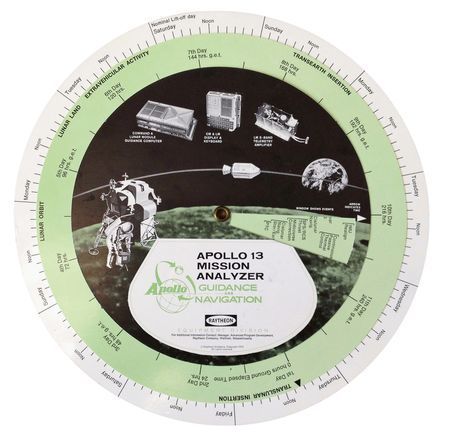 I absolutely love the informational display tools created by some of the contractors who built components for the Apollo spacecraft. I’m so interested in these things that I’ve built a little collection of them and showcased them in the book Marketing the Moon.
I absolutely love the informational display tools created by some of the contractors who built components for the Apollo spacecraft. I’m so interested in these things that I’ve built a little collection of them and showcased them in the book Marketing the Moon.
The information displays were created as giveaways to reporters and dignitaries. The displays take esoteric mission information and make it easier for non-professionals to understand.
That’s exactly what infographics of today do - make vast amounts of information visual so it is easy to understand.
These devices all have moveable components making them a pre-smartphone version of an app.
The public relations staff that instigated these unusual and valuable tools were not only creating good will for their corporate employers, they were also hoping that these objects might inspire a reporter somewhere to mention their company in print, while citing their connection to the Apollo program. Isn’t that one of the goals of today’s infographics too? Marketers and PR pros want others to talk about them in the media and on social networks.
Heck people are still writing about these cool informational displays. Here’s an article that came out a few days ago in “Slate”: Two Colorful Infographic Wheels Used to Track the Apollo Missions.
North American Rockwell PR department issued an “Apollo Mileage and Speed Converter” that reporters could use to convert the reported data, such as feet-per-second, into statute miles-per-hour, something laymen could more easily understand. (North American Rockwell is now part of Boeing.)
 The TRW “Mission Information Display”, among the most elaborate includes estimated time to touchdown for the lunar landing based on altitude as well as a listing of major event data. TRW manufactured the lunar module descent engine and other components for Apollo the Apollo program. They made this TRW Mission Information Display for Apollo 11 as a two-sided slide rule. It is, itself, an impressive feat of information design.
The TRW “Mission Information Display”, among the most elaborate includes estimated time to touchdown for the lunar landing based on altitude as well as a listing of major event data. TRW manufactured the lunar module descent engine and other components for Apollo the Apollo program. They made this TRW Mission Information Display for Apollo 11 as a two-sided slide rule. It is, itself, an impressive feat of information design.
Raytheon produced the circular “Apollo 13 Mission Guidance and Navigation Analyzer,” and similar ones for other Apollo missions, as an aid to understanding the important activities during the missions. Raytheon’s “Mission Analyzer” was used to convert NASA’s Ground Elapsed Time into a more familiar time and day of the week standard. Of course, this analyzer reflected the mission plan had everything proceeded normally. When the oxygen tank exploded in Apollo 13’s service module, the lunar landing was aborted and the mission became one of survival.
Inserting a sense of humor
Here is a fun side note for reading this far. After the book’s publication we were contacted by Monte Wallenstein who is the creator/designer of the Raytheon analyzers who told us: “Notice that on the wheels you see ; they just do not mean moon walk, but are my unique three initials MHW, anyway you turn them. The "-" between the M and W is obviously for connecting the sides of the H!”
May 14, 2014
Successful salespeople educate and inform
Our ongoing communications revolution has profoundly affected how salespeople achieve success.
Buyers are now in charge!
Referencing blogs, Twitter, LinkedIn, YouTube, Facebook and other Web-based tools, buyers often bypass the traditional selling model altogether – learning for themselves about your products and services, your competitors, and what customers say about you (whether true or not!).
Don’t struggle to adjust to this new environment — be agile and master it. You win hearts and minds by creating low-cost (and no-cost!) measurable strategies and tactics that help buyers you don’t yet know discover you!
The best salespeople have become information brokers — communicating by delivering the precise information that buyers need at just the right time and in just the right way.
Successful salespeople educate and inform
You have the power to elevate yourself on the web to a position of importance. In the e-marketplace of ideas, successful salespeople educate and inform. They highlight their expertise by sharing videos, content-rich websites, social streams, blogs, e-books, and images rather than using the old sales playbook of information hoarding and letting it drip it out. Now you’ve got to be on the buyers’ timetable. Not yours.
We also have the ability to interact and participate in conversations that other people begin on social media sites including Twitter, Facebook, LinkedIn, forums, and review sites.
The key is to focus on the buyer’s needs, not your own ego
Stop hyping your products and services. Don't rely on interruption techniques. You'll regret taking advantage of people’s time and attention with unwanted communications.
Instead you need to deliver the right information to buyers, right at the point when they are most receptive.
May 7, 2014
Social super voice at Cisco Partner Velocity
This afternoon, I delivered a keynote at the Cisco Partner Velocity event which I titled Amplify Your Brand Voice Turn Up the Volume to "11". I shared ideas for how Cisco’s partners can develop a “super voice” and reach millions.
Social media engagement at your event
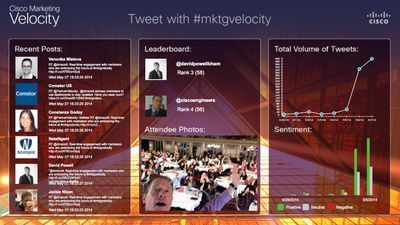 What I really like about the Cisco Partner Velocity event is how social networks have been made an integral part of the experience. Unlike most events where the organizers toss out a hashtag and that’s it, Cisco marketing and social media staff built virtual aspects into the entire event to enhance attendees’ experience.
What I really like about the Cisco Partner Velocity event is how social networks have been made an integral part of the experience. Unlike most events where the organizers toss out a hashtag and that’s it, Cisco marketing and social media staff built virtual aspects into the entire event to enhance attendees’ experience.
I particularly like the real-time social dashboard which shows tweets using the #mktgvelocity hashtag in real-time, images of attendees photos, and a leaderboard of the most active people. There’s also a graph of the number of tweets and sentiment analysis (positive vs negative tweets). Great stuff.
 Cisco social media staff were available at a social media kiosk to answer questions and help newbies. It was a popular destination among attendees. In this photo I’m with Bryan Sherlock, Corinne Dickey, and David Durham.
Cisco social media staff were available at a social media kiosk to answer questions and help newbies. It was a popular destination among attendees. In this photo I’m with Bryan Sherlock, Corinne Dickey, and David Durham.
The social stream and dashboard is also used by Cisco partners who are not actually at the event. It spreads the ideas shared at the conference beyond the venue and gets those not in the room interested in attending next year.
Events are no longer a point in time and place. Real-time technology means the event starts before people show up, it involves people who aren't physically there, and it continues after people depart. It is a new world.
Selfies are real-time
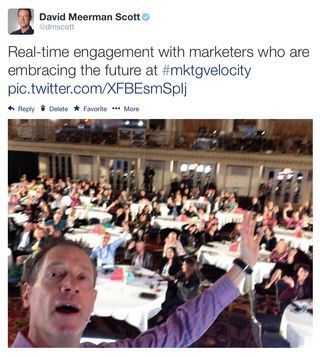 During my talk, I managed to stand on a chair and shoot a selfie of me and the audience without falling! I then tweeted it live from the stage to show the power of real-time. And a few moments later, we popped the real-time dashboard onto the screen to show the result: dozens of retweets and likes.
During my talk, I managed to stand on a chair and shoot a selfie of me and the audience without falling! I then tweeted it live from the stage to show the power of real-time. And a few moments later, we popped the real-time dashboard onto the screen to show the result: dozens of retweets and likes.
Haley tweeted a photo of my acrobatic chair move and here is the resulting selfie.
If you’re planning a live event, try to integrate social media into the core of the experience like Cisco did for the Partner Velocity event. The audience is more engaged and everyone is able to participate on the social backchannel, enriching the experience for all.
May 5, 2014
Authors of Return on a Share Report do not really value sharing
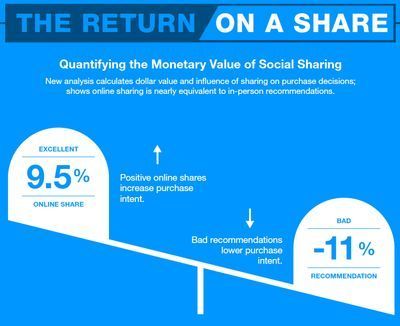 A new research report from ShareThis, the Paley Center for Media, and Beresford Research calculates dollar value and influence of sharing on purchase decisions.
A new research report from ShareThis, the Paley Center for Media, and Beresford Research calculates dollar value and influence of sharing on purchase decisions.
Interestingly, it shows something many of us have been saying for years: Online sharing is nearly equivalent to in-person recommendations.
You can download the complete infographic from which the image on the right is taken The Return on a Share with no registration required.
The Return on a Share Report
The study quantifies the monetary value of online recommendations. The report shows that online content, such as recommendations shared between friends, now influences consumer purchases more than price and brand and can motivate buyers to spend 9.5% more for a product. Interesting stuff indeed.
You can download the complete The Return on a Share Report here. Sadly, it requires registration, so I have not downloaded it for fear of being added to unwanted email lists.
Don’t squeeze people who want to share!!!
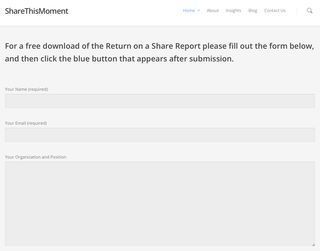 Too bad ShareThis is not learning from their own report. People are reluctant to share content that requires a registration.
Too bad ShareThis is not learning from their own report. People are reluctant to share content that requires a registration.
I find it ridiculous that this report, which talks about the value of sharing, actively discourages sharing by putting a massive gate on the content.
This report has value as a commodity to be shared and many more will do so without being squeezed. My analysis has shown that a report like this with no registration will generate 20x to 50x more downloads than one that requires registration.
Which is more valuable: 50 downloads and the resulting shares or one email address?
It seems the producers of the report are missing an opportunity to make it free with no registration to showcase the value of sharing of their own report.
More on this riff in my 2009 blog post Say NO to squeezing your buyers.
May 1, 2014
Business mashups
 My local bike shop is not just a bike shop. Rather, Ride Studio Cafe is a combination of two businesses: a high-end bike shop and an urbane cafe.
My local bike shop is not just a bike shop. Rather, Ride Studio Cafe is a combination of two businesses: a high-end bike shop and an urbane cafe.
My college bookstore isn’t really a bookstore. The Kenyon College Bookstore - the nation's longest continuously-operating college bookstore and the third-oldest bookstore of any kind in America – is a community gathering place for both Kenyon and the surrounding community.
The Showcase SuperLux near my home isn’t really a movie theater. It is a high-end restaurant that happens to show movies.
The annual South-by-Southwest conference is much more than one thing. It combines music, film, and interactive conferences in a mashup that is more fun than any single focused event.
All four of these business mashups are doing great in marketplaces that are tough. It’s fascinating to me how the combination of several businesses can mean much more than the separate parts. A bike shop next door to a cafe wouldn’t be the same.
Ride Studio Cafe
On beautiful days, people stop in Ride Studio Cafe while on a ride and grab a coffee. On rotten days, there are people inside talking all things bikes or organizing a tune-up of their machine. Many people who don’t ride prefer the atmosphere here to the nearby coffee chains. That they sell high-end bikes and gear (bikes that sell for USD $5,000 and more) is a bonus. Business is so good with repair and tune-ups that they’ve outgrown the space.
The Ride Studio—the bike shop (which I have used to build and tune up my OPEN Cycle—integrates elements of a cafe environment: warm, inviting, and friendly. The Studio Cafe brings cycling culture into cafe culture: there is a friendly energy shared by both staff and customers. This creates an environment that welcomes both riders and people who just enjoy a good cup of coffee or tea and a comfortable atmosphere.
Kenyon College Bookstore
Sure it sells books. But in a world where many college bookstores have closed or gone to chain store management, the Kenyon Bookstore sells clothing, gifts, food and drink, glassware, greeting cards, stationery, and sundries.
Perhaps more importantly, the bookstore serves as a center of social life on campus. In an article in the Wall Street Journal, a reporter noted that the store functions as "a second living room. Here, customers can sit in armchairs, eat ice cream, and read all day long without ... once getting a cold stare from an employee."
Showcase SuperLux
Popcorn and a Coke? Not here. The Showcase SuperLux is a theater featuring super plush power recliners and newest box office releases. And while you are even more comfortable than in your own living room, you can enjoy great food with a glass of wine or a cocktail. Call button service means you don’t have to leave your seat to order a steak or seafood meal.
South-by-Southwest
SXSW is hugely successful, growing each year. The first South by Southwest Music Conference and Festival was held in 1987 in Austin, Texas and in 1994, SXSW added film and interactive components. I’ve been four times and I love it because I can dip into the interactive social media tracks but also see a film premiere and catch some hot bands.
The events are almost too successful. They’ve gotten so big that it is difficult to move around in recent years. SXSW music sees 16,000 registrants while SXSW Film and SXSW Interactive events together attract approximately 32,000 registrants to Austin every March.
Your business
In tough, competitive businesses maybe some kind of mashup is the way to success.
April 29, 2014
Creepy? eBay deploys real time and personal advertising on Facebook
 This weekend I was poking around the True Religion brand jeans web site. True Religion jeans fit me really well, so I have a few pair. They are expensive, so I tend to wait for a sale to pull the trigger on a new pair.
This weekend I was poking around the True Religion brand jeans web site. True Religion jeans fit me really well, so I have a few pair. They are expensive, so I tend to wait for a sale to pull the trigger on a new pair.
I noticed a particular model called Men’s Ricky on the Road Jean but the retail price of $395 was way more than I’d spend. So I popped over to eBay and searched on “Men’s Ricky on the Road Jean” to see if there were any on offer there at a lower price. There were, but I didn't buy on eBay.
eBay remembers
 The next morning on Facebook was a personalized ad from eBay sitting on my homepage as a “Suggested Post”. The text: “Still Interested? Don’t miss out on this item!” And there was a photo of the jeans I was interested in the day before!
The next morning on Facebook was a personalized ad from eBay sitting on my homepage as a “Suggested Post”. The text: “Still Interested? Don’t miss out on this item!” And there was a photo of the jeans I was interested in the day before!
Wow. Talk about real-time personalized targeting. I’m on eBay and look at a very specific item. The next day an ad for that exact item pops up within a social network I'm in.
I've seen many examples of ads appear based on sites I had recently visited and Google searches I have made. But the ads tended to be much more generic. This was a first for me to see an eBay search I made get re-deployed as an in-context ad within Facebook targeted down to an image of the thing I was looking for.
The creepiness factor
Some people will find this sort of thing creepy. There are all sorts of privacy aspects at play here. You can imagine all sorts of scenarios, right? Imagine searching on something very personal on eBay and then the next day showing your spouse or child something on Facebook and eBay pops up your private search result into your stream. Embarrassing!
I’m not a Facebook privacy setting expert. Does anyone know if you can change Facebook settings to control this kind of advertising? The bottom line with free social networking services is that they are not free, right? Everything we do on the web is tracked and can be used somehow.
Our world has been heading to this level of targeting for a long time. Things get so personal as to be almost scary.
As a marketer, I can see lots of use for this as a tool for generating attention. As a salesperson, there are ways you could use such a thing to target a prospect in interesting ways. Imagine a B2B salesperson inserting an ad into someone's Facebook stream who just downloaded a specific white paper.
But with the power comes responsibility.
April 26, 2014
Personal branding and your new Twitter profile
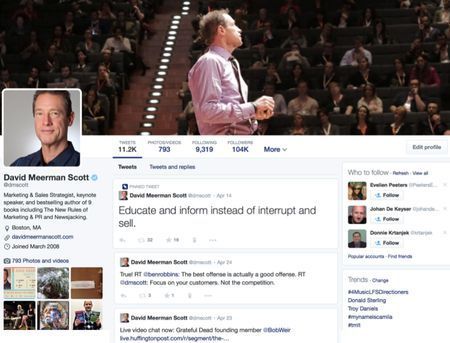 Twitter began offering a new way to showcase your personal brand. They are rolling it out selectively so if you haven’t been able to implement the new format, I’m told it should be available to you very soon.
Twitter began offering a new way to showcase your personal brand. They are rolling it out selectively so if you haven’t been able to implement the new format, I’m told it should be available to you very soon.
It seems Facebook has gotten more like Twitter, with timelines and real time updates. Now, with this change, Twitter is getting more like Facebook, making it easier for you to showcase who you are on your Twitter page, especially with the big new header image.
Most Twitter profiles don’t say enough and most have lousy design. While that’s fine if you’re just communicating with friends, if you’re using your Twitter feed for your business, you need to pay attention. With the new profile, now is a good time to focus on yours if you haven’t already done so. Here's my new @dmscott profile.
Your bio and other details are now at the left rather than the top center.
As I write this, my bio is “Marketing & Sales Strategist, keynote speaker, and bestselling author of 9 books including The New Rules of Marketing & PR and Newsjacking.” As a component of personal branding, this is a critical section. I prefer not to make it a 160-character resume from a laundry list of attributes like this: “father, husband, surfer, economics major, world traveler, marketer, and rock star wannabe.” (I confess, that would be my list.) I see this sort of thing all the time, and in my opinion it is not good for personal branding because you don’t really focus on your particular expertise. Try to be descriptive. And try to be specific.
The profile photo (your head shot) is slightly larger.
While there is no absolute right or wrong about photos in social networks like Twitter, do keep in mind that each of these choices says a great deal about you.
Some people use a cartoon avatar to represent themselves. While that’s okay for some, I do think it communicates that the person doesn’t like their real self for some reason. If you use Bart Simpson or a snowboard rather than your photo, you're limiting what you want people to think of you.
There are many choices when it comes to a photo to use. You can use a casual shot taken by a friend. This is a great option for many people. But there are many different approaches and each says something important about you. Are you in a casual setting, such as at a restaurant? Or someplace more formal, like an office? What are you wearing? A hat? Is it a casual shot of you taken on a vacation with a beer in your hand? Or a formal head-and-shoulders shot in business attire taken by a professional photographer? Smile, or no smile? How close do you crop?
I chose a simple, recent headshot in which I am wearing casual clothing. If you care about your personal brand, you should use a representative photo of you on social networks.
Best Tweets
Tweets that have received more engagement will appear slightly larger in your Twitter feed, so your best content is easy to find. I sort of like this for when I look at someone’s profile who I do not know.
Pinned Tweet
You have an opportunity to “Pin” one of your Tweets to the top of your page, so it’s always there and easy for your followers to see what you’re all about. I chose one I sent last week that says: “Educate and inform instead of interrupt and sell” because it nicely sums up my ideas on marketing and sales strategy.
Header Photo
Perhaps the biggest change, is that the header photo now spans the entire top of your Twitter page. This is some great real estate to showcase some aspect about you.
I love what my wife @YukariWatanabe did with hers – a photo of us kayaking this winter in Antarctica.
I made mine a photo of me speaking last month at BeWizard in Rimini Italy. I like how you can see the audience in the background. But I’m torn between several other photos of me speaking, one that I've used for several years until now, which I have included below. I might change. What do you think?
But one thing I won’t be doing is using this space to “advertise” like some people do. I could put the image of my books lined up. It is a cool image. But I would rather showcase me speaking than my book covers.
Have you changed your profile? Let us know your Twitter ID in a comment.
April 23, 2014
Back online after TypePad DDoS attack… hopefully
This blog, along with others hosted by TypePad, has been down for an extended period of time due to criminals executing a prolonged DDoS (distributed denial-of-service) attack.
A non-techie definition of a DDoS attack is when a huge flood of Web traffic is sent to overwhelm a website or network. Sometimes the criminals who do this demand ransom to stop, which appears to have been the case with TypePad according to TechCrunch.
A similar attack occurred recently taking down Basecamp. The post mortem about the Basecamp attack is interesting in its details on the attack.
The attack started late last week as the US was entering a holiday weekend. It appeared to have affected all TypePad blogs. The TypePad team were able to restore service to those blogs using a TypePad domain URL reasonably quickly, but blogs like mine, with custom domains, took several days longer to restore.
Early this morning is the first time I’ve been able to access my blog since last week so I am firing off this post with the hope that the problem has been solved for good.
Coping with customer complaints
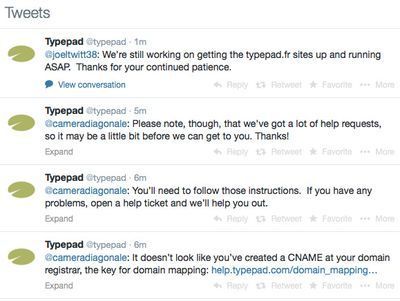 Throughout the attack, people with TypePad blogs were obviously frustrated. TypePad support staff worked close to 24x7 over the weekend to restore service and to communicate what was happening.
Throughout the attack, people with TypePad blogs were obviously frustrated. TypePad support staff worked close to 24x7 over the weekend to restore service and to communicate what was happening.
Since TypePad’s own customer support communications relies on the TypePad service, it was tough to get word out about what was happening. Communications was primarily on @TypePad Twitter with thousands of tweets of both a general nature and as specific responses to people, including me, sent in real-time.
What about my data!?!
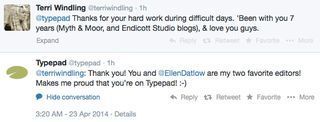 In the early stages of the attack, I was most concerned about the content of my blog. Would the data be safe? I’ve written this blog on TypePad for ten years and the thought of well over 1,000 blog posts being compromised worried the hell out of me. Scanning the TypePad Twitter feed, it seemed that others had the same worry, and TypePad continually assured people that the data was safe.
In the early stages of the attack, I was most concerned about the content of my blog. Would the data be safe? I’ve written this blog on TypePad for ten years and the thought of well over 1,000 blog posts being compromised worried the hell out of me. Scanning the TypePad Twitter feed, it seemed that others had the same worry, and TypePad continually assured people that the data was safe.
As the attack wore on into the 3rd and 4th and 5th day, I just watched and wondered what it was like to be working on the problem and communicating to customers. I cond of got mesmerized by the TypePad Twitter feed as I was thinking about what it must be like to be working there during the outage.
People were obviously frustrated and some chose to vent, sometimes with venom, to the people at TypePad trying to fix the problem. People will be people and I understand this. Some companies rely on TypePad for a Website that represents their sole livelihood. If you run an ecommerce site, imagine seeing your business fall to zero. That would certainly raise the blood pressure.
What would you do if you were working Twitter support full time?
I watched the Twitter feed carefully. Here are some takeaways from how TypePad responded to people:
Consistency - I’d see the same messages such as “We’re going to get you back up and running as soon as possible” pop up frequently in response to people. This was interesting in that anybody scanning the TypePad twitter feed would know the status within seconds. Perhaps they were using TextExpander on the communications desk. That’s what I would be doing.
Keep your cool - The TypePad Twitter feed continually delivered thoughtful and measured responses in the face of what must have been a huge barrage of very negative inbound traffic from customers.
Don’t over promise – Many people demanded to know when the problem would be fixed. Despite being pushed, TypePad never over promised by giving a date or time. This was a smart move because had they said something like “hopefully tomorrow” and missed that line in the sand by several days, they would really frustrate people.
Be human – The responses to people were genuine. People were cheering TypePad and they replied appropriately. Indeed, TypePad deployed humor now and then when they could. This served to calm people and many ended up thanking TypePad staff for their hard work or even offering to send the office hugs and cookies.
Plan for a crisis – I’m not sure if TypePad had a crisis plan in place, but a huge lesson from this is that a major problem can affect anyone. Even you. Especially you. Are you prepared?
April 17, 2014
Late to bed early to rise, work like hell and advertise
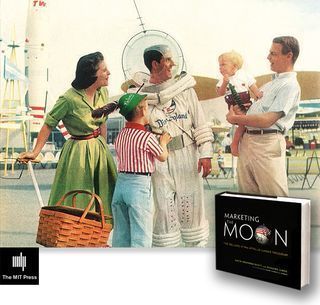 My book Marketing the Moon, which I wrote with Rich Jurek and with a forward from Gene Cernan, the last man on the moon, has now been out for about a month.
My book Marketing the Moon, which I wrote with Rich Jurek and with a forward from Gene Cernan, the last man on the moon, has now been out for about a month.
The book has gotten off to a terrific start. We were interviewed by Kai Ryssdal for a five minute segment on NPR Marketplace which aired on Monday; the Wall Street Journal featured the book with a half page in a Weekend Edition; we scored a coveted one sentence review in the New York Times Sunday Magazine “U.S. government goes ‘Mad Men’ on Apollo, gets it right”; and many other bloggers and media outlets have written about us including Gizmodo, Brain Pickings, and the Boston Globe.
We continue to work with Robert Stone, an Academy Award nominated filmmaker who is working on a documentary based on the book.
While these are indeed exciting developments, one of the things that Rich and I worried about the most with this book was how the people who worked on Apollo in the 1960s and 1970s would react to it.
Would the journalists who covered the story at the time agree with us? How about the public affairs staffers from NASA and the PR people from the contractors, would they appreciate our take on the story? And what would the astronauts who were in many ways the "product" of the marketing efforts, many of whom we interviewed for the book say?
"Marketing of Apollo may be the only marketing effort remembered of our generation. It was epic."
It is immensely gratifying as authors that so far everything we’ve heard from those who worked on Apollo has been enthusiastically positive.
For example Ed Buckbee, who worked on Apollo and has been associated with the U.S. missile and space programs for five decades, wrote this review:
It's finally been written, how a bunch of government-types who never worked for the government managed to market and create a brand known as NASA with the mission, "We choose to go to the moon," and we did. Twenty-four American astronauts flew from Planet Earth to the moon and twelve astronauts walked on the moon. It was done with the press and everyone watching around the world.
A new book entitled, "Marketing the Moon," by David Meerman Scott and Richard Jurek is just out and it is a must read for all who followed manned space flight in the 60's and 70's. Journalism students who missed that era might want to download it between classes.
Little did we know that this governmental agency — NASA — would create a relationship with the press that has not been matched, certainly not by another government agency. We in NASA operated within the statute of an agency that "must provide the widest possible dissemination of information to the public."
At times it was a struggle to convince engineers who ran the agency, that we must be transparent, we were not a skunk works nor a black-ops program. NASA was different. Many thought NASA was not a part of government but a bunch of nerds taking us on fabulous journeys into space. We had a saying, "late to bed early to rise, work like hell and advertise!" Marketing of Apollo may be the only marketing effort remembered of our generation. It was epic.
Having worked for Wernher von Braun, at NASA's Marshall Space Flight Center, I can assure you he never turned down a request from the press. In 1968, Richard Lewis, Chicago Sun Times science writer, was invited to witness a Saturn static test firing. When informed he was coming von Braun said, "a very nice constructive man. I would like to meet him." Von Braun was a PR man's dream.
Houston had the astronauts but Huntsville had Wernher von Braun. And that made all the difference.
Ed Buckbee, an author, lecturer and historian, has been associated with the U.S. missile and space programs for five decades. Buckbee began his career in 1959 as a U.S. Army officer at the Army Ordnance Missile Command, Redstone Arsenal. Al. and later, joined NASA's Marshall Space Flight Center as a public affairs official. He is director emeritus of the U.S. Space & Rocket Center and founder of U.S. Space Camp. Buckbee worked with the von Braun team for fifteen years. As the Space Center's first director and curator, he established the Wernher von Braun collection and has collaborated extensively with historians in the U.S. and abroad. Buckbee is widely known in the U.S. as an advocate of human spaceflight.
April 15, 2014
Flash Boys and the power of story
 I just finished Michael Lewis’ fantastic new book Flash Boys: A Wall Street Revolt and enjoyed it immensely. I’ve been a Lewis fan from the beginning. Lewis is about my age and his book Liar’s Poker, which I loved, released when I was working on Wall Street in the 1980s.
I just finished Michael Lewis’ fantastic new book Flash Boys: A Wall Street Revolt and enjoyed it immensely. I’ve been a Lewis fan from the beginning. Lewis is about my age and his book Liar’s Poker, which I loved, released when I was working on Wall Street in the 1980s.
Lewis has gotten tons of press for Flash Boys. He was on 60 Minutes, a huge way to launch a book and since then he seems to be everywhere in the media. Walking through a bunch of airports last week, I saw piles and piles of the book stacked in not only airport bookstores, but newsstands as well.
Flash Boys is a story about High Frequency Traders operating in Wall Street’s equity markets. And it is a story about real-time. The book is not without controversy as Lewis describes HFT a way of “rigging” the market to take money from each and every investor. HFT professionals disagree and have been on a campaign to defend the practice. Many others have debated HFT as outlined in the book and I’ll leave those discussions to other outlets.
I want to focus on Lewis' writing instead.
The power of story
In my opinion, the reason Flash Boys is doing so well (all that media resulting in a rank of number 3 of all books on USA Amazon and number 1 on the New York Times bestseller list as I write this) is because of story. Lewis has taken the complex and arcane world of trading stocks in real-time measured in milliseconds, a subject most would find boring and complicated, and turned it into a story filled with heroes and villains and conflict.
CHARACTERS: It is the story of one group of Wall Street professionals who expose the down sides of high frequency trading and walk away from million dollar salaries in order to reform the markets. And it’s about another group of Wall Street professionals who will do seemingly anything currently legal to make money, even if it includes shaving a percentage away from everybody who invests in the stock market.
HERO: There’s a hero in Lewis story: mild-mannered Bradley Katsuyama who worked at sleepy Royal Bank of Canada. Like many traders, Katsuyama experienced strange behavior on his real-time screens whenever he went to buy or sell shares on behalf of his customers. But unlike other traders, he dug deep to find out the cause and then created an infrastructure to fix it. He is a hero like you normally find in fiction, yet this story is true.
CONFLICT: The story drips with conflict, a topic I discuss in my own free ebook Gaijin Male Model: A Case Study in Conflict-Driven Business Writing. Unlike typical business writing that focuses on the facts, Lewis brings his stories alive by showing how people are in conflict with other people and how they are in conflict with institutions. Writing without conflict is propaganda.
CLIFFHANGER: The meat of the book focuses on how the hero and his cohorts solve the mystery of how HFT works. It is a story of detective work that exposes flaws in the US financial market system. And like a debut mystery novel from an author planning on a series of books, the last very last paragraph of the epilogue involves a doozy of a cliffhanger. That last paragraph challenges the reader to learn more. (If you read that far and are interested, Google the number.)
What business content creators can learn from Flash Boys
As I was reading the book, I was enjoying elements usually found in fiction within this nonfiction book. I was thinking how these techniques can be used by any nonfiction writer, but typically are not.
Writing about interesting characters, creating conflict, making a hero, and having elements that challenge a reader to want to learn more can make your own writing come alive.
Read Flash Boys for the story. But learn from it to make your own content better too.



